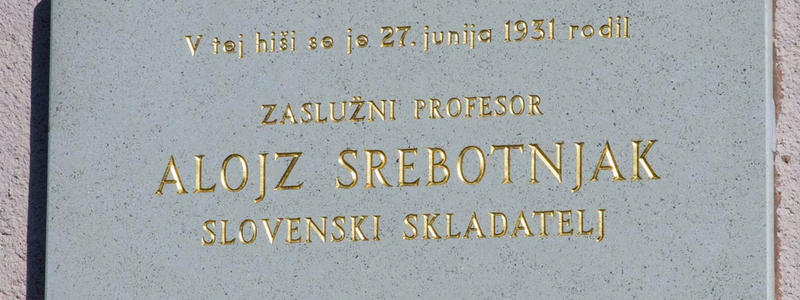On 21 June 2018, on the initiative of Postojna Local Community, a memorial plaque was attached to the composer’s birthplace. The marble plaque, conceptually designed by Erika Merše Logar, was made in a Postojna stonemasonry workshop, Kamnoseštvo Kobe Dušan s.p.
Alojz Srebotnjak
Composer and educator Alojz Srebotnjak (1931–2010) was a preeminent figure of contemporary Slovenian art music. He was member of a group of modernist composers, Pro musica viva, and one of the most radical Slovenian composers employing the 12-tone technique of composition in the nineteen-sixties. His musical output includes choral compositions, lieder, two cantatas, chamber and orchestral pieces, theatre music and film scores.
He received primary and secondary education in his native town of Postojna, where he also attended a music school. He took piano lessons with Božena Soban. Srebotnjak continued his music education in Ljubljana and graduated in 1953, in 1958 completing an additional course in composition at the Academy of Music in Ljubljana in the class of Lucijan Marija Škerjanc. While pursuing his studies at the Ljubljana Academy, Srebotnjak attended the Chigiana Musical Academy in Siena for two years, also taking a summer composition course under Vito Franzi and studying film music composition with Francesco Lavagnino. After graduation, he obtained further specialisation in Rome with composer Boris Porena, in London with composer Peter R. Fricker and in Paris.
After gaining an insight into diverse styles and techniques of composition, Srebotnjak found himself increasingly drawn to neo-expressionism, following a path that led him to dodecaphony and serialism. Some of his typical 12-tone compositions include Serenata, Monologi, Šest skladb (Serenade, Monologues, Six Compositions) and Antifona (Antiphony). In time, Srebotnjak also came to embrace aleatoricism. A characteristic feature of his oeuvre, Srebotnjak was known to adopt, re-work and adapt works by Slovenian modernists, including Osterc, Kogoj and Bravničar. He tended to incorporate folk music elements into his compositions, displaying a proclivity for Macedonian melodies in addition to Slovenian tunes. He also wrote some valuable film music, primarily scores for films by France Štiglic.
Srebotnjak brought a style of his own to his favoured modernist methods of composition. He interlaced traditional forms with dodecaphony in his landmark piece Invenzione variata for piano, and further developed this style of composition in the work Serenata (Serenade) for flute. The next turning point in his composing output was Micro songs for voice and 13 instruments, whereby Srebotnjak first extended the boundaries of standard music texture by introducing aleatory music. He incorporated elements of graphic notation and sounds of the local fire brigade siren into the piece Naïf, thus fostering the use of concrete music.
His most notable choral and vocal-instrumental compositions include Zborovske pesmi na tekste Srečka Kosovela (Choral Songs Based on Texts by Srečko Kosovel), as well as Rezijanska and Kraška jesen (A Song from Resia, Karst Autumn).
Srebotnjak also achieved distinction as an educator. He taught music-theory subjects at the Academy of Education in Ljubljana from 1964. Between 1970 and 2001, he taught composition at the Academy of Music in Ljubljana, holding the post of a full professor from 1981. He was later designated a professor emeritus. Srebotnjak received numerous awards in recognition of his work, most notably the Golden Arena for Best Film Music at the Pula Film Festival (1964, 1974), the Prešeren Foundation Award (1965), the Prešeren Award for Lifetime Achievement (1999), the Kozina Award (2000) and the Župančič Lifetime Achievement Award (2005).
Maia Juvanc


